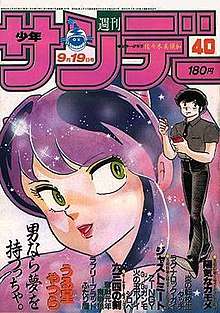Weekly Shōnen Sunday
 1984 Vol. 40 featuring Urusei Yatsura on the cover. | |
| Editor | Yu Torimitsu |
|---|---|
| Former editors | Masaki Nawata |
| Categories | Shōnen manga[1][2] |
| Frequency | Weekly |
| Circulation |
330,000[2] (July–September, 2016) |
| First issue | March 17, 1959 |
| Company | Shogakukan |
| Country | Japan |
| Language | Japanese |
| Website | websunday.net |
Weekly Shōnen Sunday (Japanese: 週刊少年サンデー Hepburn: Shūkan Shōnen Sandē) is a weekly shōnen manga magazine published in Japan by Shogakukan since March 1959. Contrary to its title, Weekly Shōnen Sunday issues are released on Wednesdays. Weekly Shōnen Sunday has sold over 1.8 billion copies since 1986, making it the third best-selling comic/manga magazine, behind only Weekly Shōnen Jump and Weekly Shōnen Magazine.
History
Shōnen Sunday was first published on March 17, 1959[3] as a response to its rival Weekly Shōnen Magazine. The debut issue featured Shigeo Nagashima, the star player of the Yomiuri Giants on the cover, and a congratulatory article by Isoko Hatano, a noted child psychologist.
Despite its name, Shōnen Sunday was originally published on Tuesdays of each week, switching to Wednesdays in 2011. The "Sunday" in the name was the creation of its first editor, Kiichi Toyoda, who wanted the title to be evocative of a relaxing weekend.

Shōnen Sunday's distinctive "pointing finger" that appears in the lower corner of every page on the left side of the magazine made its subtle debut in the 4/5 issue from 1969. This understated feature, ever present but easily overlooked, was referenced as a plot element in 20th Century Boys. Sunday's more noticeable mascot, a helmeted fish debuted in the 1980s.
Prior to the 1990s and 2000s no serial in Shōnen Sunday had run over 40 volumes, but that began to change with series such as Detective Conan, Major, Inuyasha, Shijō Saikyō no Deshi Kenichi and Karakuri Circus, which maintained a high level of popularity.
In a rare event due to the closeness of the two magazine's founding dates, Weekly Shōnen Sunday and Weekly Shōnen Magazine released a special combined issue[4] on 19 March 2008. In addition, other commemorative events, merchandise, and manga crossovers were planned for the following year as part of the celebrations.[5] The book Shonen Sunday 1983 was published on 15 July 2009 to celebrate the anniversary and the magazines heyday. It reprints manga from 1983, such as Urusei Yatsura and Touch, and has interviews with their creators as well as artists who were inspired by the series from that period, such as Gosho Aoyama.[6]
To celebrate Weekly Shōnen Sunday's 55th anniversary, 55 new manga series were launched in the print and online magazines Weekly Shonen Sunday, Shonen Sunday S, Ura Sunday, and Club Sunday throughout the year beginning in March 2014.[7]
Features
Series
There are currently 30 manga titles being serialized in Weekly Shōnen Sunday, some are released monthly and others are currently on hiatus.
| Series title | Author | Premiered |
|---|---|---|
| Amano Megumi wa Sukidarake! (天野めぐみはスキだらけ!) | Nekoguchi | August 2015 |
| Aozakura: Bouei Daigakukou Monogatari (あおざくら 防衛大学校物語) | Hikaru Nikaidou | April 2016 |
| Arata: The Legend (アラタ カンガタリ〜革神語〜) | Yū Watase | October 2008 |
| Ariadne in the Blue Sky (蒼穹のアリアドネ) | Norihiro Yagi | December 2017 |
| Be Blues! - Ao ni Nare (BE BLUES!〜青になれ〜) | Motoyuki Tanaka | January 2011 |
| Birdmen (バードメン) | Yellow Tanabe | July 2013 |
| Daiku no Hatou (第九の波濤) | Michiteru Kusaba | April 2017 |
| Detective Conan (名探偵コナン) | Gosho Aoyama | January 1994 |
| Detective Conan: Zero's Tea Time (名探偵コナン ゼロの日常) | Takahiro Arai, Gosho Aoyama | May 2018 |
| Gin no Saji Silver Spoon (銀の匙 Silver Spoon) | Hiromu Arakawa | April 2011 |
| Gopun Go no Sekai (5分後の世界) | Hiroshi Fukuda | April 2018 |
| Hatsukoi Zombie (初恋ゾンビ) | Ryou Minenami | October 2015 |
| Hoankan Evans no Uso: Dead or Love (保安官エヴァンスの嘘~DEAD OR LOVE~) | Mizuki Kuriyama | April 2017 |
| Kimi wa 008 (君は008) | Syun Matsuena | February 2018 |
| Komi-san wa, Komyu-shou desu. (古見さんは、コミュ症です。) | Tomohito Oda | May 2016 |
| Maiko-san chi no Makanai-san (舞妓さんちのまかないさん) | Aiko Koyama | December 2016 |
| MAJOR 2nd (メジャーセカンド) | Takuya Mitsuda | March 2015 |
| Marry Grave (マリーグレイブ) | Hidenori Yamaji | December 2017 |
| Maoujou de Oyasumi (魔王城でおやすみ) | Kagiji Kumanomata | May 2016 |
| Memesis (メメシス) | Takuya Yagyuu | February 2018 |
| Psyche Matashitemo (サイケまたしても) | Tsubasa Fukuchi | July 2014 |
| RYOKO | Kaito Mitsuhashi | October 2016 |
| Sōbōtei Kowasubeshi (双亡亭壊すべし) | Kazuhiro Fujita | March 2016 |
| switch (スイッチ) | Atsushi Namikiri | April 2018 |
| Tantei Xeno to Nanatsu no Satsujin Misshitsu (探偵ゼノと七つの殺人密室) | Kyoichi Nanatsuki, Teppei Sugiyama | November 2017 |
| Tokachi Hitoribocchi Nouen | Yuuji Yokoyama | December 2017 |
| Tonikaku Kawaii (トニカクカワイイ) | Kenjiro Hata | February 2018 |
| Youkai Giga (妖怪ギガ(仮)) | Satsuki Satou | April 2017 |
| Yugami-kun ni wa Tomodachi ga Inai (湯神くんには友達がいない) | Jun Sakura | May 2012 |
| Zettai Karen Children (絶対可憐チルドレン) | Takashi Shiina | July 2004 |
Circulation
| Year / Period | Weekly circulation | Magazine sales | Sales revenue (est.) | Issue price |
|---|---|---|---|---|
| 1986 | 1,600,000[8] | 83,200,000[8] | ¥14,976,000,000 | ¥180[9] |
| 1987 | 1,300,000[8] | 67,600,000[8] | ¥12,168,000,000 | |
| 1988 | 1,300,000[8] | 67,600,000[8] | ¥12,168,000,000 | |
| 1989 | 1,400,000[8] | 72,800,000[8] | ¥13,104,000,000 | |
| 1990 | 1,350,000[8] | 70,200,000[8] | ¥12,636,000,000 | |
| 1991 | 1,350,000[8] | 70,200,000[8] | ¥12,636,000,000 | |
| 1992 | 1,350,000[8] | 70,200,000[8] | ¥13,338,000,000 | ¥190[9] |
| 1993 | 1,270,000[8] | 66,040,000[8] | ¥12,547,600,000 | |
| 1994 | 1,270,000[8] | 66,040,000[8] | ¥13,868,400,000 | ¥210[9] |
| 1995 | 1,400,000[8] | 72,800,000[8] | ¥15,288,000,000 | |
| 1996 | 1,530,000[8] | 79,560,000[8] | ¥21,481,200,000 | ¥270[10] |
| 1997 | 1,650,000[8] | 85,800,000[8] | ¥23,166,000,000 | |
| 1998 | 1,700,000[8] | 88,400,000[8] | ¥23,868,000,000 | |
| 1999 | 1,630,000[8] | 84,760,000[8] | ¥22,885,200,000 | |
| 2000 | 2,020,000 | 105,040,000[8] | ¥28,360,800,000 | |
| 2001 | 1,500,000[8] | 78,000,000[8] | ¥21,060,000,000 | |
| 2002 | 1,530,000 | 79,560,000 | ¥21,481,200,000 | |
| 2003 | 1,310,000 | 68,120,000 | ¥18,392,400,000 | |
| 2004 | 1,160,913[11] | 60,367,476[11] | ¥16,299,218,520 | |
| 2005 | 1,068,265[11] | 55,549,780[11] | ¥14,998,440,600 | |
| January 2006 to August 2006 | 1,003,708[11] | 34,795,211[11] | ¥9,394,706,970 | |
| September 2006 to December 2006 | 1,010,000 | 17,506,667 | ¥4,726,800,090 | |
| 2007 | 940,000 | 48,880,000 | ¥13,197,600,000 | |
| 2008 | 873,438[12] | 45,418,776[12] | ¥12,263,069,520 | |
| January 2009 to September 2009 | 773,062[13] | 30,149,418[13] | ¥8,140,342,860 | |
| October 2009 to September 2010 | 678,917[14] | 35,303,684[14] | ¥9,531,994,680 | |
| October 2010 to September 2011 | 611,146[15] | 31,779,592[15] | ¥8,580,489,840 | |
| October 2011 to September 2012 | 539,521[16] | 28,055,092[16] | ¥7,574,874,840 | |
| October 2012 to September 2013 | 512,250[17] | 26,637,000[17] | ¥7,165,353,000 | ¥269[10][18] |
| October 2013 to September 2014 | 456,375[19] | 23,731,500[19] | ¥6,407,505,000 | ¥270[18] |
| October 2014 to September 2015 | 390,143[20] | 20,287,436[20] | ¥5,477,607,720 | |
| October 2015 to September 2016 | 350,521[21] | 18,227,092[21] | ¥4,921,314,840 | |
| October 2016 to September 2017 | 317,458[22] | 16,507,816[22] | ¥4,457,110,320 | |
| October 2017 to March 2018 | 302,167[23] | 7,856,342[23] | ¥2,121,212,340 | |
| 1986 to March 2018 | 1,876,972,882 | ¥448,682,441,140 ($4,000,021,763) |
Editors
- 1959–1960
- Kiichi Toyoda[24]
- 1991–1993
- Takashi Hirayama
- 1994–2000
- Toyohiko Okuyama
- 2000–2002
- Shinichiro Tsuzuki
- 2002–2004
- Shinichi Mikami
- 2005–2009
- Masato Hayashi
- 2009–2012
- Masaki Nawata
- 2012–present
- Yu Torimitsu
International versions
Elex Media Komputindo published an Indonesian version of Weekly Shōnen Sunday titled Shōnen Star from 2005 to 2013.
Viz Media began a Shonen Sunday imprint for titles in North America; starting with Rumiko Takahashi's Kyōkai no Rinne, which was released on October 20, 2009.
See also
References
- ↑ Thompson, Jason (2007). Manga: The Complete Guide. Del Rey Books. p. xxiii-xxiv. ISBN 978-0-345-48590-8.
- 1 2 "Boy's Manga" (in Japanese). Japanese Magazine Publishers Association. September 2016. Retrieved November 6, 2016.
- ↑ "Japanese Language Magazines Releases". Patlabor. Retrieved 25 October 2015.
- ↑ "Shōnen Sunday's 50th Anniversary". Rumic World. 13 April 2008.
- ↑ "Shōnen Magazine Shōnen Sunday Mark 50th Anniversary". Anime News Network. 18 March 2008.
- ↑ "Shonen Sunday 1983 Book Honors Manga Magazine's Heyday". Anime News Network. 9 July 2009.
- ↑ "Shonen Sunday Family to Launch 55 Manga to Mark 55th Year". Anime News Network. 3 March 2014.
- 1 2 3 4 5 6 7 8 9 10 11 12 13 14 15 16 17 18 19 20 21 22 23 24 25 26 27 28 29 30 31 "コミック誌の部数水準". Yahoo! Japan. Retrieved March 6, 2007.
- 1 2 3 "An Analysis of Weekly Manga Magazines Price for the Past 30 Years". ComiPress. 2007-04-06.
- 1 2 "Weekly Shonen Sunday's Price Cut Leads to 30% Sales Jump". Anime News Network. 2013-07-24.
- 1 2 3 4 5 6 "Manga Anthology Circulations 2004-2006". ComiPress. 2007-12-27.
- 1 2 "Where's The Manga Magazine Bailout?". Manga Cast. 2009-02-22. Retrieved 2010-02-04.
- 1 2 "2009 Japanese Manga Magazine Circulation Numbers". Anime News Network. 2010-01-18. Retrieved 2010-02-04.
- 1 2 "2010 Japanese Manga Magazine Circulation Numbers". JMPA. 2010-06-01. Retrieved 2010-08-08.
- 1 2 "JMPAマガジンデータ : 男性 コミック". Japan Magazine Publishing Association. Retrieved October 14, 2012.
- 1 2 "JMPAマガジンデータ : 男性 コミック". Japan Magazine Publishing Association. Retrieved October 22, 2013.
- 1 2 "JMPAマガジンデータ : 男性 コミック". Japan Magazine Publishing Association. Retrieved November 17, 2014.
- 1 2 "Shogakukan's Weekly and Monthly Shonen Sunday Go Digital from Today". Crunchyroll. July 13, 2016.
- 1 2 "JMPAマガジンデータ : 男性 コミック". Japan Magazine Publishing Association. Retrieved November 16, 2015.
- 1 2 "JMPAマガジンデータ : 男性 コミック". Japan Magazine Publishing Association. Retrieved October 3, 2016.
- 1 2 "JMPAマガジンデータ : 男性 コミック". Japan Magazine Publishing Association. Retrieved November 9, 2017.
- 1 2 "JMPAマガジンデータ : 男性 コミック". Japan Magazine Publishing Association. Retrieved June 21, 2018.
- 1 2 "印刷部数公表". Japan Magazine Publishing Association. Retrieved August 10, 2018.
- ↑ "Shonen Sunday's 1st Editor Kiichi Toyoda Passes Away". Anime News Network. 2013-01-15.
External links
- Official website (in Japanese)
- Viz Media's Shonen Sunday page
- Weekly Shōnen Sunday at Anime News Network's encyclopedia